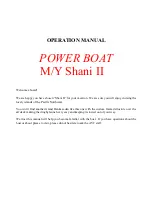
•
Keep your engine well tuned to decrease exhaust hydrocarbon
emissions that pollute the air and water.
ANCHORING YOUR BOAT
Anchoring is necessary if you stop for recreation or an emergency.
Practice anchoring techniques to make sure you know what to do
when an emergency occurs. The size and weight of your boat gov-
ern the weight of the anchor and the diameter of the anchor line.
Your Chaparral dealer can help you select the proper anchoring
equipment for your boat.
Use a burying anchor, such as a Danforth or plow anchor, which
grips into the bottom and holds your boat secure. Holding power
should be more important than weight. For anchoring in relatively
quiet waters, you can use a mushroom anchor as an alternative.
The length of the anchor line should be six to eight times the depth
of the water to ensure that the anchor bites into the bottom. The bot-
tom end of the anchor line should be galvanized chain which holds
up well as the line moves back and forth on the bottom. The rest of
the line should be nylon anchor line which stretches to soften the
impact of wind and waves on your boat.
Following are general guidelines for anchoring your boat:
•
Secure the anchor line to the bow eye or deck cleat. Do not tie
line to hardware not designed to support this stress.
•
Use two or more anchors if anchoring overnight or extended
periods of time. Otherwise, make sure your boat has enough
space to swing full circle in case of shifting winds.
•
Keep the anchor and line in an area where it will be readily
available in an emergency.
Dropping Anchor
1. Have a crew member carefully lower anchor, keeping a slight
tension on the line as the anchor drops. Maintain tension after
the anchor reaches the bottom. Simply throwing the anchor
overboard usually fouls the line and requires starting over.
2. Maneuver the boat backwards slowly until the proper length of
line is run out.
3. Fasten the anchor line around the bow eye or deck cleat.
Anchor flukes should dig into bottom and hold boat in position.
4. Check shoreline landmarks at the time anchor is dropped and
check again 30 minutes later. If position has changed, anchor is
dragging and must be reset.
Weighing Anchor
Weighing, or pulling in the anchor, requires moving the boat in the
direction of the anchor and pulling in the anchor as the boat
moves. For this reason, the engines should be running. When the
line is vertical, pull up firmly on the anchor line to free the flukes
from the bottom. If the anchor remains stuck, feed out a few feet
of line and attach it to the bow cleat. Maneuver the boat around
the anchor, keeping the line taut, until you find an angle that will
pull the anchor free.
5-13
WARNING:
Keep anchor secure while underway to prevent
damage or injury if boat’s attitude changes suddenly.
Содержание 2012 Signature
Страница 16: ...1 7...
Страница 17: ......
Страница 125: ......
Страница 133: ......
Страница 140: ...WIRING SCHEMATICS 12 12 1 Signature 370 Bilge D C Distribution Harness...
Страница 141: ...12 2 Signature 370 Helm Circuit Breaker Panel...
Страница 142: ...12 3 Signature 350 Bilge D C Distribution Harness...
Страница 143: ...12 4 Signature 350 Helm Circuit Breaker Panel...
Страница 144: ...12 5 Signature 330 Fwd D C Distribution Harness...
Страница 145: ...12 6 Signature 330 Helm Circuit Breaker Panel...
Страница 146: ...12 7 Signature 310 Aft D C Bilge Distribution Harness...
Страница 147: ...12 8 Signature 310 Helm Circuit Breaker Panel...
Страница 148: ...12 9 Signature 290 Bilge D C Distribution Harness...
Страница 149: ...12 10 Signature 290 Helm Circuit Breaker Panel...
Страница 150: ...12 11 Signature 270 Bilge D C Distribution Harness...
Страница 151: ...12 12 Signature 270 Helm Circuit Breaker Panel...
















































